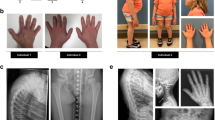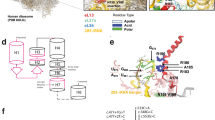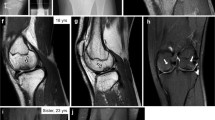Abstract
Multiple epiphyseal dysplasia (MED) is a relatively mild and clinically variable osteochondrodysplasia, primarily characterized by delayed and irregular ossification of the epiphyses and early-onset osteoarthritis1,2,3. Mutations in the genes encoding cartilage oligomeric matrix protein (COMP) and type IX collagen (COL9A2 and COL9A3) have previously been shown to cause different forms of MED (refs. 4–13). These dominant forms of MED (EDM1–3) are caused by mutations in the genes encoding structural proteins of the cartilage extracellular matrix (ECM); these proteins interact with high affinity in vitro14,15. A recessive form of MED (EDM4) has also been reported; it is caused by a mutation in the diastrophic dysplasia sulfate transporter gene16 (SLC26A). A genomewide screen of family with autosomal-dominant MED not linked to the EDM1–3 genes17 provides significant genetic evidence for a MED locus on the short arm of chromosome 2 (2p24–p23), and a search for candidate genes identified MATN3 (ref. 18), encoding matrilin-3, within the critical region. Matrilin-3 is an oligomeric protein that is present in the cartilage ECM. We have identified two different missense mutations in the exon encoding the von Willebrand factor A (vWFA) domain of matrilin-3 in two unrelated families with MED (EDM5). These are the first mutations to be identified in any of the genes encoding the matrilin family of proteins and confirm a role for matrilin-3 in the development and homeostasis of cartilage and bone.
This is a preview of subscription content, access via your institution
Access options
Subscribe to this journal
Receive 12 print issues and online access
$209.00 per year
only $17.42 per issue
Buy this article
- Purchase on Springer Link
- Instant access to full article PDF
Prices may be subject to local taxes which are calculated during checkout





Similar content being viewed by others
References
Unger, S.L. et al. Multiple epiphyseal dysplasia: radiographic abnormalities correlated with genotype. Pediatr. Radiol. 31, 10–18 (2001).
Haga, N. et al. Stature and severity in multiple epiphyseal dysplasia. J. Pediatr. Orthop. 18, 394–397 (1998).
Treble, N.J., Jensen, F.O., Bankier, A., Rogers, J.G. & Cole, W.G. Development of the hip in multiple epiphyseal dysplasia. Natural history and susceptibility to premature osteoarthritis. J. Bone Joint Surg. 72, 1061–1064 (1990).
Briggs, M.D. et al. Pseudoachondroplasia and multiple epiphyseal dysplasia due to mutations in the cartilage oligomeric matrix protein gene. Nature Genet. 10, 330–336 (1995).
Briggs, M.D. et al. Diverse mutations in the gene for cartilage oligomeric matrix protein in the pseudoachondroplasia-multiple epiphyseal dysplasia disease spectrum. Am. J. Hum. Genet. 62, 311–319 (1998).
Muragaki, Y. et al. A mutation in the gene encoding the alpha 2 chain of the fibril- associated collagen IX, COL9A2, causes multiple epiphyseal dysplasia (EDM2). Nature Genet. 12, 103–105 (1996).
Holden, P. et al. Identification of novel pro-alpha2(IX) collagen gene mutations in two families with distinctive oligoepiphyseal forms of multiple epiphyseal dysplasia. Am. J. Hum. Genet. 65, 31–38 (1999).
Bonnemann, C.G. et al. A mutation in the alpha 3 chain of type IX collagen causes autosomal dominant multiple epiphyseal dysplasia with mild myopathy. Proc. Natl. Acad. Sci. USA 97, 1212–1217 (2000).
Lohiniva, J. et al. Splicing mutations in the COL3 domain of collagen IX cause multiple epiphyseal dysplasia. Am. J. Med. Genet. 90, 216–222 (2000).
Spayde, E.C. et al. Exon skipping mutation in the COL9A2 gene in a family with multiple epiphyseal dysplasia. Matrix Biol. 19, 121–128 (2000).
Deere, M., Sanford, T., Francomano, C.A., Daniels, K. & Hecht, J.T. Identification of nine novel mutations in cartilage oligomeric matrix protein in patients with pseudoachondroplasia and multiple epiphyseal dysplasia. Am. J. Med. Genet. 85, 486–490 (1999).
Loughlin, J. et al. Identification of five novel mutations in cartilage oligomeric matrix protein gene in pseudoachondroplasia and multiple epiphyseal dysplasia Hum. Mutat. Suppl. S10–S17 (1998).
Ikegawa, S. et al. Novel and recurrent COMP (cartilage oligomeric matrix protein) mutations in pseudoachondroplasia and multiple epiphyseal dysplasia. Hum. Genet. 103, 633–638 (1998).
Holden, P. et al. Cartilage oligomeric matrix protein interacts with type IX collagen, and disruptions to these interactions identify a pathogenetic mechanism in a bone dysplasia family. J. Biol. Chem. 276, 6046–6055 (2001).
Thur, J. et al. Mutations in cartilage oligomeric matrix protein causing pseudoachondroplasia and multiple epiphyseal dysplasia affect binding of calcium and collagen I, II, and IX. J. Biol. Chem. 276, 6083–6092 (2001).
Superti-Furga, A. et al. Recessively inherited multiple epiphyseal dysplasia with normal stature, club foot, and double layered patella caused by a DTDST mutation. J. Med. Genet. 36, 621–624 (1999).
Mortier, G.R., Chapman, K.L., Leroy, J.L. & Briggs, M.D. Clinical and radiographic features of multiple epiphyseal dysplasia not linked to the COMP or type IX collagen genes. Eur. J. Hum. Genet. (in the press).
Belluoccio, D., Schenker, T., Baici, A. & Trueb, B. Characterization of human matrilin-3 (MATN3). Genomics 53, 391–394 (1998).
Wagener, R. et al. Structure and mapping of the mouse matrilin-3 gene (Matn3), a member of a gene family containing a U12-type AT-AC intron. Mamm. Genome 11, 85–90 (2000).
Chen, Q., Zhang, Y., Johnson, D.M. & Goetinck, P.F. Assembly of a novel cartilage matrix protein filamentous network: molecular basis of differential requirement of von Willebrand factor A domains. Mol. Biol. Cell 10, 2149–2162 (1999).
Aszodi, A. et al. Normal skeletal development of mice lacking matrilin 1: redundant function of matrilins in cartilage? Mol. Cell. Biol. 19, 7841–7845 (1999).
Maddox, B.K. et al. The fate of cartilage oligomeric matrix protein is determined by the cell type in the case of a novel mutation in pseudoachondroplasia. J. Biol. Chem. 272, 30993–30997 (1997).
Delot, E., Brodie, S.G., King, L.M., Wilcox, W.R. & Cohn, D.H. Physiological and pathological secretion of cartilage oligomeric matrix protein by cells in culture. J. Biol. Chem. 273, 26692–26697 (1998).
Hecht, J.T. et al. Characterization of cartilage oligomeric matrix protein (COMP) in human normal and pseudoachondroplasia musculoskeletal tissues. Matrix Biol. 17, 269–278 (1998).
Hecht, J.T. et al. Retention of cartilage oligomeric matrix protein (COMP) and cell death in redifferentiated pseudoachondroplasia chondrocytes. Matrix Biol. 17, 625–633 (1998).
Sasaki, T. et al. A Bethlem myopathy Gly to Glu mutation in the von Willebrand factor A domain N2 of the collagen alpha3(VI) chain interferes with protein folding. FASEB J. 14, 761–768 (2000).
International Working Group on Constitutional Diseases of Bone. International nomenclature and classification of the osteochondrodysplasias (1997). Am. J. Med. Genet. 79, 376–382 (1998).
Briggs, M.D. Screening for mutations in cartilage ECM genes. Methods Mol. Biol. 139, 133–145 (2000).
Acknowledgements
We thank the families for their help and interest in this study, D. Tuckwell, A. Wallace and C. Baldock for helpful discussions and J. Leroy who originally diagnosed MED in family A. M.D.B. and J.L. are Research Fellows of the Arthritis Research Campaign (ARC) and the support of the ARC (grant B0644 to M.D.B. and M.E.G.), the Royal Society (grant 20911 to M.D.B.) and The Flanders Fund for Scientific Research (grant G.0013.97 to G.R.M.) is gratefully acknowledged. Genotyping was performed in the ARC Epidemiology Research Unit (ARC-ERU) at the University of Manchester. We thank S. Eyre (ARC-ERU) and K. Walker (Pyrosequencing AB) for their help with some of these studies.
Author information
Authors and Affiliations
Corresponding author
Supplementary information
Rights and permissions
About this article
Cite this article
Chapman, K., Mortier, G., Chapman, K. et al. Mutations in the region encoding the von Willebrand factor A domain of matrilin-3 are associated with multiple epiphyseal dysplasia. Nat Genet 28, 393–396 (2001). https://doi.org/10.1038/ng573
Received:
Accepted:
Published:
Issue Date:
DOI: https://doi.org/10.1038/ng573
This article is cited by
-
Transcriptome sequencing identifies prognostic genes involved in gastric adenocarcinoma
Molecular and Cellular Biochemistry (2023)
-
Efficacy of matrilin-3-primed adipose-derived mesenchymal stem cell spheroids in a rabbit model of disc degeneration
Stem Cell Research & Therapy (2020)
-
A novel p.A191D matrilin-3 variant in a Vietnamese family with multiple epiphyseal dysplasia: a case report
BMC Musculoskeletal Disorders (2020)
-
Comparative analysis demonstrates cell type-specific conservation of SOX9 targets between mouse and chicken
Scientific Reports (2019)
-
Dual novel mutations in SLC26A2 in two siblings with multiple epiphyseal dysplasia 4 from a Chinese family: a case report
BMC Medical Genetics (2018)



